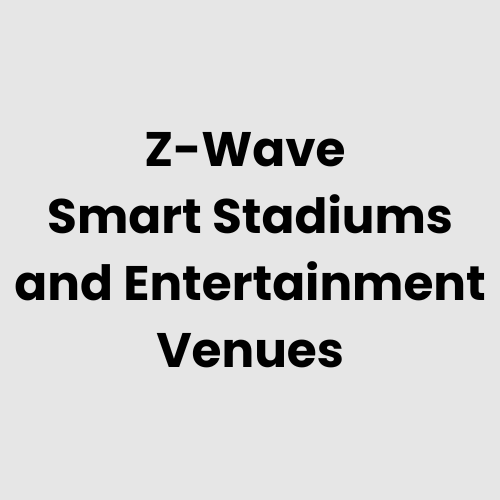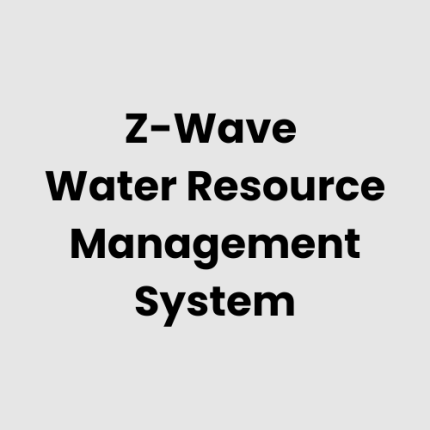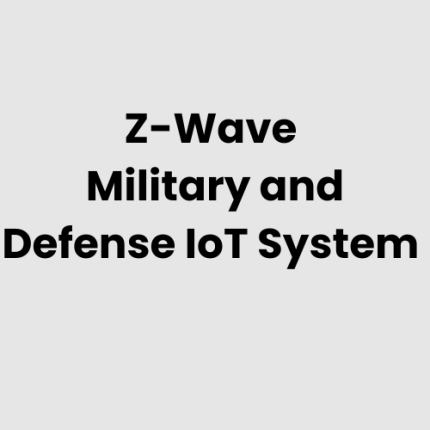Description
Technical Architecture of Z-Wave Enabled Smart Stadiums and Entertainment Venues System
The technical architecture of Z-Wave Enabled Smart Stadiums and Entertainment Venues leverages a centralized control system integrated with a network of Z-Wave smart devices. The architecture typically consists of
- Z-Wave Hub: Acts as the central controller, connecting all smart devices within the venue, such as lighting, HVAC, security, and ticketing systems.
- IoT Sensors and Actuators: These devices monitor crowd movement, temperature, lighting levels, and security systems. They can automatically adjust the environment based on real-time data.
- Cloud/Local Servers: Data is either stored locally or in the cloud for analysis, ensuring real-time monitoring and management.
- User Interfaces: Accessible via smartphones, kiosks, or remote terminals, these interfaces allow staff and customers to interact with the system, enhancing guest experience and operational efficiency.
Hardware of Z-Wave Enabled Smart Stadiums and Entertainment Venues System
The key hardware components for a Z-Wave Enabled Smart Stadium or Entertainment Venue include
- Z-Wave Hub/Controller: Central unit for managing the network of connected devices.
- Z-Wave Motion Sensors: Detect crowd movement, occupancy levels, and changes in foot traffic to optimize lighting and HVAC.
- Z-Wave Lighting and HVAC Control Modules: Automatically adjust to maintain optimal energy efficiency and comfort for attendees.
- Z-Wave Security Cameras and Door Locks: Enhance stadium security, allowing remote monitoring and access control.
- Smart Ticketing Systems: Integrate with the Z-Wave system to streamline guest entry and monitor attendance.
- Environmental Sensors: Monitor air quality, humidity, and temperature, ensuring a comfortable and safe environment for patrons.
Physical Placement Considerations of the Hardware of Z-Wave Enabled Smart Stadiums and Entertainment Venues System
When placing hardware in a stadium or entertainment venue, key factors to consider include:
- Signal Range: Z-Wave devices should be placed within the optimal range to maintain connectivity, with repeaters used where necessary to extend range.
- Safety and Security: Sensors should be placed at entry points, parking areas, and high-traffic zones for maximum monitoring, while security cameras must cover all critical areas.
- Visitor Flow: Devices such as motion sensors and crowd management systems should be placed at strategic locations (e.g., entryways, seating areas, and food courts) to monitor crowd density and movement patterns.
- Accessibility: Devices should be placed in locations that are accessible for maintenance but not disruptive to the venue’s aesthetics or operations.
Hardware Architecture of Z-Wave Enabled Smart Stadiums and Entertainment Venues System
The hardware architecture for Z-Wave Enabled Smart Stadiums and Entertainment Venues involves the integration of multiple Z-Wave devices to ensure seamless operations across various functions:
- Core Network Layer: This includes the Z-Wave Hub, which connects all other devices, such as lighting and environmental control systems, to the main platform.
- Edge Devices: Z-Wave sensors and actuators installed in key areas to gather data and perform localized actions, such as adjusting temperature or turning off lights when not needed.
- Data Collection Layer: Environmental, motion, and security sensors collect data, which is transmitted to the central system or cloud for analysis.
- User Interaction Layer: This layer consists of mobile apps, kiosks, or stadium-specific interfaces that allow staff or customers to interact with the smart systems in real-time.
Deployment Considerations of Z-Wave Enabled Smart Stadiums and Entertainment Venues System
When deploying Z-Wave systems in smart stadiums and entertainment venues, consider the following:
- Scalability: Z-Wave systems are highly scalable, allowing easy expansion to accommodate more devices as the venue grows or as new features are required.
- Integration with Existing Infrastructure: The Z-Wave system should be able to integrate with the venue’s existing lighting, HVAC, and security systems, reducing the need for major infrastructure overhauls.
- Redundancy and Reliability: Ensure there is redundancy in critical systems such as power and network connectivity to maintain functionality during large events or emergencies.
- Data Security: Given the high volume of personal and operational data, ensure that all data transmitted between devices is encrypted and protected from unauthorized access.
List of Relevant Industry Standards and Regulations (without descriptions)
- ISO/IEC 27001 (Information Security Management)
- ISO 9001 (Quality Management Systems)
- UL 294 (Access Control Systems)
- IEEE 802.15.4 (Low Rate Wireless Personal Area Networks)
- NIST SP 800-53 (Security and Privacy Controls)
- FCC Part 15 (Radio Frequency Devices)
- GDPR (General Data Protection Regulation)
- ADA (Americans with Disabilities Act) Compliance
- IEC 62443 (Industrial Communication Networks)
- PCI DSS (Payment Card Industry Data Security Standard)
Local Server Version: Running with a Local Server
In some cases, Z-Wave Enabled Smart Stadiums and Entertainment Venues may operate with a local server, particularly where a highly controlled environment or limited cloud access is preferred. This setup allows the venue’s control system to operate independently from external networks, ensuring faster response times for critical operations. It also ensures that sensitive data remains within the venue’s premises for enhanced security. Local servers can connect directly to the Z-Wave Hub and manage real-time data analysis, event scheduling, and system diagnostics.
Cloud Integration and Data Management
Cloud integration for Z-Wave Enabled Smart Stadiums and Entertainment Venues provides scalability and centralized management across multiple venues. The cloud allows real-time data analysis and enables predictive analytics for operational efficiency. Data such as crowd movement, energy consumption, and security activity can be continuously monitored and optimized remotely. Additionally, the cloud facilitates remote maintenance and support, reducing the need for on-site interventions. GAO Tek’s solutions ensure secure cloud infrastructure, offering seamless integration between the local systems and cloud for enhanced flexibility and operational performance.
GAO Case Studies
United States
- Los Angeles, California
A major sports venue in Los Angeles implemented a Z-Wave smart system to streamline crowd management and enhance the fan experience. The system optimized energy use by controlling lighting and HVAC, reducing costs during events and non-event periods. Real-time data from motion sensors helped direct crowds efficiently, ensuring safety and comfort. - New York City, New York
A renowned entertainment complex in New York City integrated Z-Wave smart devices for enhanced security and operational management. Motion sensors were installed throughout the venue to monitor foot traffic, while automated lighting and climate control adjusted based on crowd size, contributing to energy savings and an improved visitor experience. - Chicago, Illinois
A stadium in Chicago incorporated Z-Wave technology to create a seamless and secure environment for fans. Smart locks and cameras integrated into the venue’s infrastructure allowed for secure access control, while real-time monitoring of environmental conditions ensured optimal comfort for attendees during events. - Miami, Florida
A large stadium in Miami used Z-Wave smart technology to enhance crowd flow and energy management. The venue deployed smart lighting and environmental control systems that adjusted to crowd movement, reducing energy usage during idle times. Z-Wave-enabled sensors helped track occupancy and optimize space utilization throughout the facility. - Dallas, Texas
In Dallas, a large arena adopted Z-Wave-enabled sensors to monitor the venue’s HVAC and lighting systems. These systems adjusted automatically in response to real-time data, reducing energy consumption while maintaining optimal comfort levels. The integration of Z-Wave technology provided better security and operational efficiency during major events. - San Francisco, California
A well-known sports complex in San Francisco deployed Z-Wave technology to enhance safety and guest services. With the integration of motion sensors and automated lighting, the system helped manage crowd density and security, while also improving energy efficiency throughout the venue. - Las Vegas, Nevada
A major entertainment venue in Las Vegas implemented Z-Wave technology to enhance guest experience and optimize venue operations. Smart HVAC systems adjusted automatically based on real-time occupancy data, ensuring a comfortable environment while reducing energy costs during off-peak hours. - Atlanta, Georgia
In Atlanta, Z-Wave systems were integrated into a newly constructed stadium to manage lighting, climate, and security systems. The venue’s lighting system was automated to adjust based on crowd density, while Z-Wave-enabled cameras and sensors enhanced security, providing real-time data for facility managers. - Seattle, Washington
A popular concert venue in Seattle adopted Z-Wave technology to optimize guest services and reduce energy costs. Automated environmental controls and smart ticketing systems streamlined venue operations, improving crowd flow while offering a more personalized experience for guests. - Denver, Colorado
In Denver, a major stadium implemented Z-Wave-enabled smart systems to improve operational efficiency. Smart lighting and HVAC systems responded to crowd movement, ensuring energy savings without compromising comfort. Additionally, Z-Wave sensors provided insights into crowd behavior, helping to streamline event logistics. - Houston, Texas
A large venue in Houston leveraged Z-Wave technology to automate lighting, security, and climate systems. Real-time sensor data from crowd movement was used to adjust lighting and temperature in various sections of the venue, ensuring the best possible experience for guests while reducing operational costs. - Phoenix, Arizona
A stadium in Phoenix implemented a Z-Wave system to enhance energy efficiency and crowd management. By integrating Z-Wave-enabled lighting and HVAC controls, the venue was able to reduce power consumption during off-peak hours. Additionally, motion sensors helped to streamline guest flow and improve safety. - Orlando, Florida
Z-Wave technology was used in an entertainment venue in Orlando to integrate security systems, lighting, and climate control. Automated features like temperature adjustments based on occupancy and real-time crowd monitoring improved the venue’s energy efficiency and overall operational effectiveness. - Charlotte, North Carolina
A major stadium in Charlotte utilized Z-Wave-enabled smart systems to optimize lighting, security, and HVAC. The system adjusted lighting and climate based on real-time data, improving energy efficiency and ensuring a comfortable environment for attendees. Smart security cameras monitored high-traffic areas. - Boston, Massachusetts
A Boston-based sports arena used Z-Wave technology to improve venue operations. Sensors were placed throughout the venue to monitor crowd movement, adjusting lighting and HVAC systems in response. The system also provided data on audience behavior, allowing managers to streamline event processes and improve security.
Canada
- Toronto, Ontario
A major sports complex in Toronto implemented Z-Wave smart technology to improve the fan experience and optimize energy use. The system included motion sensors for crowd management and automated climate control, which adjusted based on real-time occupancy data to ensure comfort and energy savings during events. - Vancouver, British Columbia
In Vancouver, a large entertainment venue used Z-Wave-enabled devices to enhance safety and efficiency. Automated lighting and climate controls were integrated to adjust based on crowd movement, ensuring an optimal environment while reducing energy costs. Z-Wave sensors also provided real-time security insights to improve guest safety.
Navigation Menu for Z-Wave
- Z- Wave Gateways/Hubs
- Z-Wave End Devices
- Z-Wave-Cloud, Server, PC& Mobile System
- Z-Wave Accessories
- Z-Wave Resources
Navigation Menu for IoT
- LORAWAN
- ZIGBEE
- Wi-Fi HaLow
- Z-WAVE
- BLE & RFID
- NB-IOT
- CELLULAR IOT
- GPS IOT
- IOT SENSORS
- EDGE COMPUTING
- IOT SYSTEMS
Our products are in stock and can be shipped anywhere in the continental U.S. or Canada from our local warehouse. For any further information, please fill out this form or email us.
We are actively looking for partners who are like us located in the U.S. and Canada. For more information on partnering with GAO, please visit Partner with GAO Tek Inc. It lists various ways to partner with GAO, such as OEM Partnerships, Technology Integration, Distribution and Reselling Opportunities, Presenting at the Leading Event Tek Summit, Joint R&D Projects, Training and Consulting Services, Industry-Specific Collaborations, Research and Academic Partnerships.



